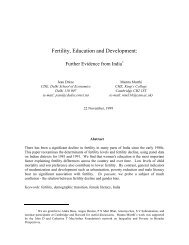You also want an ePaper? Increase the reach of your titles
YUMPU automatically turns print PDFs into web optimized ePapers that Google loves.
LESSONS FROM THE SOUK<br />
Early in the 1950s, officials in the treasury of the Arabian Kingdom of Yemen noticed<br />
something funny happening to their country’s currency. <strong>The</strong> main unit of money, a<br />
solid silver coin called the Rial, was disappearing from circulation. <strong>The</strong>y traced the<br />
disappearing coins south to the trading port of Aden, then a British colony and<br />
military bastion commanding the entrance to the Red Sea and southern approaches<br />
to the Suez Canal.<br />
Inquiries found that an Indian clerk named Dhirubhai Ambani, then barely into his<br />
twenties, had an open order out in the souk (marketplace) of Aden for as many Rials<br />
as were available. Ambani had noted that the value of the Rial’s silver content was<br />
higher than its exchange value against the British pound and other foreign<br />
currencies. So he began buying Rials, melting them down, and selling the silver<br />
ingots to bullion dealers in London. ‘he margins were small, but it was money for<br />
jam, Dhirubhai later reminisced. After three months it was stopped, but I made a<br />
few lakhs [one lakh = 100000 rupees] of rupees. I don’s believe in not taking<br />
opportunities.” Dhirubhai had gone to Aden soon after finishing his studies in<br />
Junagadh at the age of 16, following the long tradition of boys from Bania families in<br />
Kathiawar heading for the Arabian trading ports or the market towns of East Africa to<br />
gain commercial experience and accumulate capital.<br />
A network of personal contacts kept jobs within the same community. Dhirubhai’s<br />
elder brother Ramniklal, known as is Ramnikbhai, had gone to Aden two years<br />
before, and was working in the car sales division of A. Besse & Co. Founded by a<br />
Frenchman named Antonin Besse, the company had developed from trading in<br />
animal hides and incense between the world wars into the biggest commercial house<br />
in the Red Sea area, selling cars, cameras, electrical goods, pharmaceuticals, oil<br />
products and food commodities to both British and French territories in the Arab<br />
world and the Horn of Africa, as well as to Ethiopia.<br />
Another Gujarati, Maganbhai Patel, from the Porda district, joined Besse as a junior<br />
accountant at the age of 18 in 1931 and was made a director in 1948. He estimates<br />
the company controlled about 80 per cent of the region’s commerce soon after the<br />
Second World War. It had 30 branches, and six to eight ships of its own in the<br />
subsidiary Halal Shipping. It was indeed successful: shortly before his death at the<br />
age of 72 in 1948, Antonin Besse made a donation of one million pounds to endow St<br />
Anthony’s College in Oxford.<br />
<strong>The</strong>reafter, the company was run by two of his sons, Tony and He was hired, and<br />
soon after arrived by steamer in Aden. As Susheel Kothari notes: ‘<strong>The</strong> first sight of<br />
Aden is always a shock.’ <strong>The</strong> oil-filled blue waters of the port are backed by steep<br />
crags of dark-brown rock, remnants of an old volcano, with no sign of vegetation.<br />
Aden had flourished in Roman times as a way station on trading routes between<br />
Egypt and India. <strong>The</strong> opening of the Suez Canal in 1869 revived its importance, and<br />
it became a major coaling port for European shipping to Asia and Australasia. From<br />
its occupation by a detachment of Indian sepoys sent by the East India Company in<br />
1839, Aden had been an important link in the ties of Britain to the Indian Raj. Until<br />
1937, when it was put under the Colonial Office in London, the territory was<br />
administered from India. <strong>The</strong> Indian rupee circulated as its currency until it was<br />
replaced by the East African shilling in 1951.




